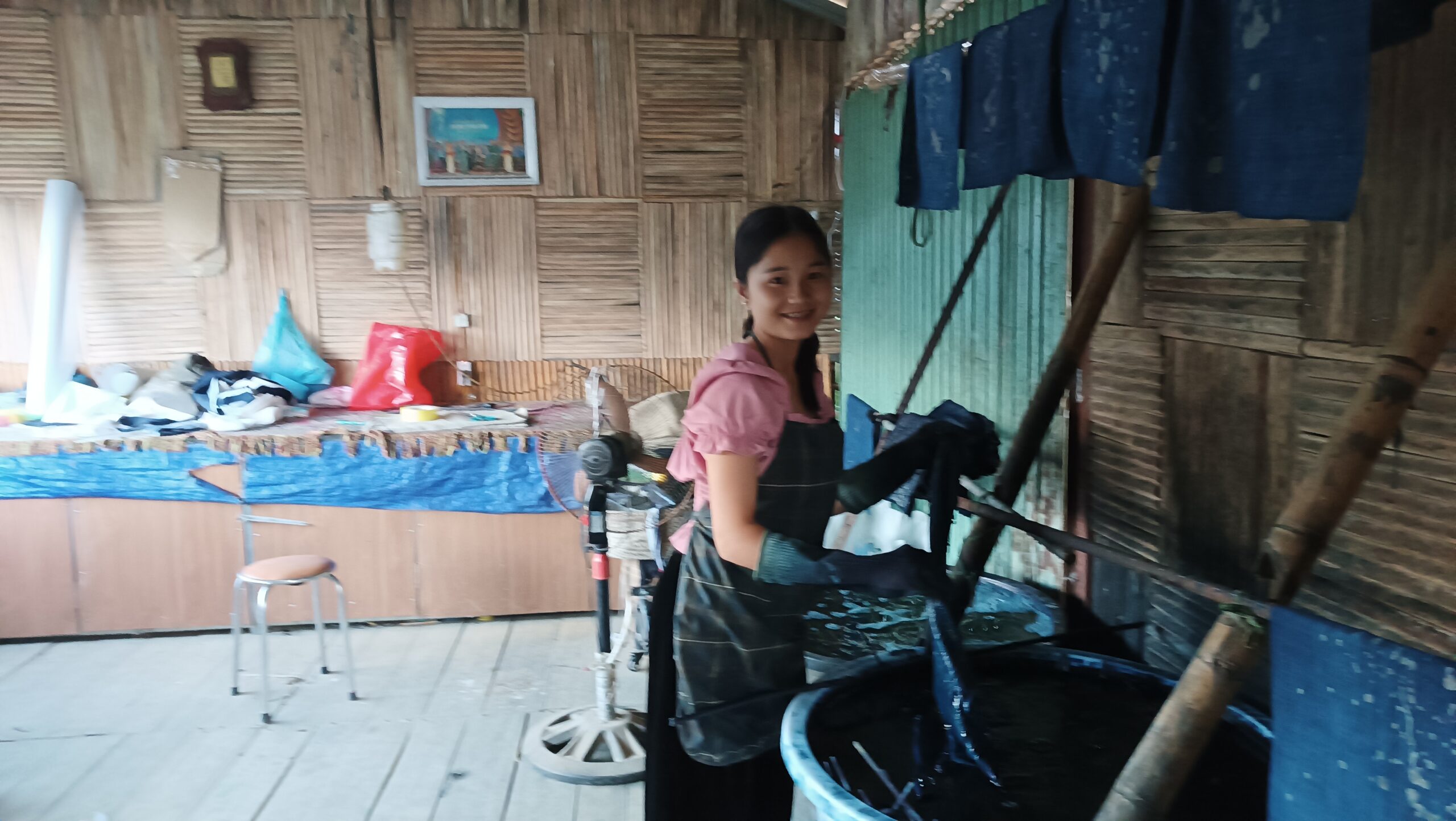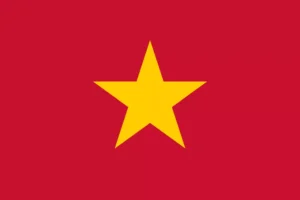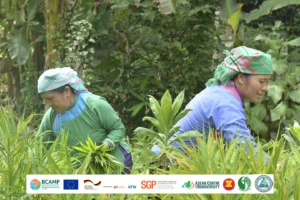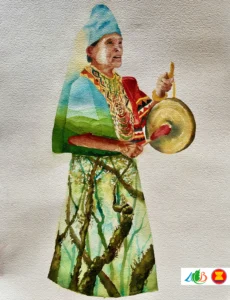In Hoang Lien
Locals living in Hoang Lien National Park spanning both Lao Cai and Lai Chau provinces, Vietnam’s mountainous Northwest, cannot be more different. Different ethnic groups (Yao, Giáy, Tày, Xa Pho, H’mong etc) and their sub-groups are scattered around, constituting a cultural mosaic, besides the large variety of fauna and flora on offer and seasons changing within a day. Be that as it may, there is one thing they would have in common: hospitality. They would welcome any stranger to their homes, no matter whether you speak their languages, whether you come on an exploratory visit or simply need a break during your journeys. Oftentimes, they greet you with a sweet and self – deprecating smile: “Our family does not have much”. Yet the more you talk to them and admire their places, the more you will be amazed at how rich they are: each family has a treasure trove of biodiversity wisdom.
Their brocade and family gardens are such a testimony.
Brocade is a memento
Mrs Mảy’s family is no exception. Her name, a popular name among Yao women, means beauty. She is living with her husband and two children in Tả Phìn, a well-known commune in Hoàng Liên in a spacious house made of fokienia and bamboo. Tả Phìn, which means The Great Plain in Yao language, is located in the Northeastern Part of Sapa town in Lao Cai province. Just like other women from the Yao ethnic group, Mẩy learned how to embroider as a teenage girl from her mother and sisters. Brocade has been part and parcel of her childhood and womanhood.
“Self – embroidered bags and wedding dresses are our lifelong treasures”, said Mẩy in her hesitant Vietnamese language, who proudly introduced patterns on her self – made brocade shoes.
“In Dao culture, embroidery is a must for women and it showcases femininity, diligence and dexterity”, said Mẩy.
In brocade products, Yao people never fail to capture their attachment to forests. Forests and families are nothing but connected. Forests are at their disposal. Cotton, ramie and flax have been their friends. As the proverb of the Yao goes: “We live in the forest, we count on it”.
Yao people, known in Vietnamese as Dao, refer to themselves as “keman”, or people of the forest in their language. In his poem “Bring me back to the mountains when I die”, Yao poet Triệu Kim Văn wrote:
…Bring me back to the mountains when I die
So my soul will find its root
In the wilderness where I drink water from rock bellies.
The night flickers with the fire of the shack roof…
People fancy catching pupae
Hunting to the whole village’s delight…
The most sophisticated labor of love for each Yao woman is the wedding clothes that they would wear on their wedding day, the embroidery of which might take years to complete. Brocade wedding clothes are nothing but lifelong love mementos or dowries.
On the brocade wallets, bags, backpacks or wedding gowns, descriptions of nature are nothing but a must.
“When you see our clothes, you see mountains and forests”, said Mẩy.
The same philosophy applies to Tày people. For them, heaven is the creator of all beings. Animals and plants are born to complement human beings. Brocade would not be wholesome without the images of other species.
Ms Thào Sung, a well – known brocade Hmong artisan in Lào Cai, explains her brocade patterns, which she has learned from her teacher, who could not read or write in H’mong language. Her hands were in a distinct indigo color, as she had to work with indigofera leaves day by day. In her various products, she often features H’mong perception of nature. It is to remind people that human beings are living together with other non – human beings.
“Human beings need to learn from other species”, said Sung.
“People in the sacred mountains
Learn the way of ants to crawl uphill
(The day I grew up)
For example, she loves to feature snails on her self – made scarfs. According to Hmong’s people observations, snails have a long life expectancy. In the past, H’mong people often died young. Thus, they are envious of snails for living long, based on their own observations.
“We do not know how long a snail can live, but whenever we harvest, we can see that they are still there on the field”, said Sung.
Also, Hmong people observe that bird’s eyes can see far and wide, thus birds’ eyes patterns appear regularly on their brocade, expressing their wishes to have bright eyes.
For Yao people, a gorgeous piece of clothing should include five colors, yet the main color still needs to be red, the symbol of luck.
Gardening
In her own garden with more than 30 species of flowers and herbal plants, Mẩy struggled to name each and every of them in Vietnamese language.
“I only know the names of these plants in Dao language, but I do not know how to write them. I remember them by heart”, said Mẩy, who does not know how to write her own name in Yao language.
Mẩy find it hard to teach her children those names either. They grew up picking up VIetnamese language at school, and do not know how to write their own indigenous language either.
Like other parents, she could only teach them by naming the functions of plants.
Nini, a H’mong tour guide, has been facing the same issues. When asked by tourists as to what plants her family has been using for brocade production, she was often at a loss for words.
“My hands always have the color of indigo plant leaves”, said Nini.
In fact, over 3000 plant species have been recorded in the park, including many endemic and endangered species.
Tẩn Vần Siệu, who was recognized as the People’s teacher by the government, with more than three decades of dedication to the teaching of Dao characters in his own tutoring class, did not seem to be convinced.
“I am sure there should be more than 3000 species”, said Siệu, who highlights the Dao people’ forest worshiping ceremony every May.
Other ethnic groups also boast this cultural practice.
When asked why, they just said: Because the forest is full of mystery. For the local people in Hoang Lien, each species represents a set of solutions to our lives.
Siệu explained that every name of a region contains its slice of history, which is not known to most people who only speak Vietnamese. For example, “Séo Mý Tỉ”, in Chinese characters 小米地, means the land of rice.
As teacher Siệu described, the forest worshiping ceremony is as important as the ancestor death anniversary for the Yao people.
As they all did not know the Dao characters, word of mouth teaching and circulation of indigenous knowledge was key. As they did not know how to say those plants in Vietnamese for Vietnamese clients, they could only note down on each packet: medicine for joint mobility, medicine against gout, medicine for energy boost, etc.
Yet, for Tả, the son of Mẩy, who is now taking classes of Dao reading and writing, these labels are very misleading, because plants and animals are multifunctional.
“If we write that this plant is to cure gout, people would believe that it only serves to treat one disease, but one plant can treat multiple diseases”, said Tả.
Lò Thị Cái from Tày ethnic group also learned to memorize trees and their functions during her whole childhood.
“They are all great sources of medicine. I cannot remember them all”, said Cái.
Her husband seconded her hesitant words in Vietnamese.
“Plants might be useful separately or together with other plants. We will never know what other functions they might have”, said her husband.
For the Dao, Mong, Giáy and Xa Phó ethnic groups scattered around Hoàng Liên national park, herbal medicine is the first thing they would turn to when falling ill. They would only turn to doctors when they have no idea what plants are of service.
Pastor Sùng A Phềnh, a H’mong blacksmith – cum – pastor at a local church in Sử Pán village could not agree more.
In his own garden, he grew different species, some of which were taken from the forests.
“Unfortunately, I do not know all of their functions. We are too small and too benighted to know about our nature”, said Pastor Sung.
Yet certain beliefs still hold them back.
The pandemic, while having hurt their trade, barely affected their food security. While they survive on homegrown vegetables stemming from the huge biodiversity of Hoang Lien, they avoid eating them on the first day of the lunar new year, as the richly available vegetables bode ill for the remainder of the year.
“If we eat vegetable on the first day, we are doomed to eat poorly for the rest of the year”, said Phẩu, a Dao tour guide.
Some plants are believed to be toxic and inedible, so people would turn away or choose to discuss them.
Brocade handicrafts have been waning in the past decade. The decline was even compounded by the ebbing tourism due to the pandemic in the past two years . Mẩy does not make any attempt to conceal her sadness as younger generations are no longer driven to create brocade on their own. On the one hand, brocade products are very labor – saving. On the other hand, they do not sell well.
Yet, young people embrace and advocate for biodiversity in just different ways.
Chảo Mẩy, is now embarking on her start-up promoting natural cosmetic products to many parts of the world.
While nature is dear to their heart, none of the interviewed locals knows about the origin of the name Hoang Lien. It remains a myth as its biodiversity.
The sky-high Hoang Lien
The clear blue stream flows around the forest edge
The immense steppe,
Looming over the pass: the shadow of the H’mong girl
Teeming with joy
Beside the boy who follows the sun back to the mountain
and the earnest sound of the khen panpipes.
The village is jubilant, bustling with mountains and forests
The song resounds
to celebrate the good harvest of the mountain
The river is immense, heavy with yellow flowers
Far away to the horizon
The smoke factory spreads across the mountains
Dispel the wandering clouds.
The sky-high Hoang Lien
The vast mountainside is red with the colors of the flag
The highlands of our homeland
The electricity is shining on the top of Hoang Lien
Bright in the mountains, bright forever in our hometown.
















